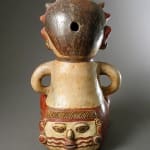Terracotta Female Effigy, 1100 CE - 1500 CE
Terracotta
17
PF.4732
Further images
Human effigies during this period often show female or male figures in upright poses, with legs extended or bent at the knees and hands on hips. Stylistically there are similarities,...
Human effigies during this period often show female or male figures in upright poses, with legs extended or bent at the knees and hands on hips. Stylistically there are similarities, particularly in the coloration of a brownish body under a creamy-buff slip, burnished with black or dark reddish brown and red paint. However, similarities end when presented with an extraordinary figure such as this one. There are a number of remarkable features in this seated female. She is beautifully decorated with elaborate tattooing; especially interesting in the bold vertical bands of alternating dark red, black and white on her face. The prominent breasts indicate she is indeed a woman, yet the protuberance in the groin suggests a male. This may be the artist's representation of female genitals, or an abstract interpretation of birth. Her squat pose, position of hands and open mouth suggests she is in labor. Red circles inside her mouth may be a symbol of pain. The most amazing aspect is the face on her buttocks. The features are distinctive and as realistic as those of the main figures. This may represent a guardian deity, or even an actual part of the woman's clothes. This effigy is unique among a unique genre, possessing a power and presence that is truly spectacular.





